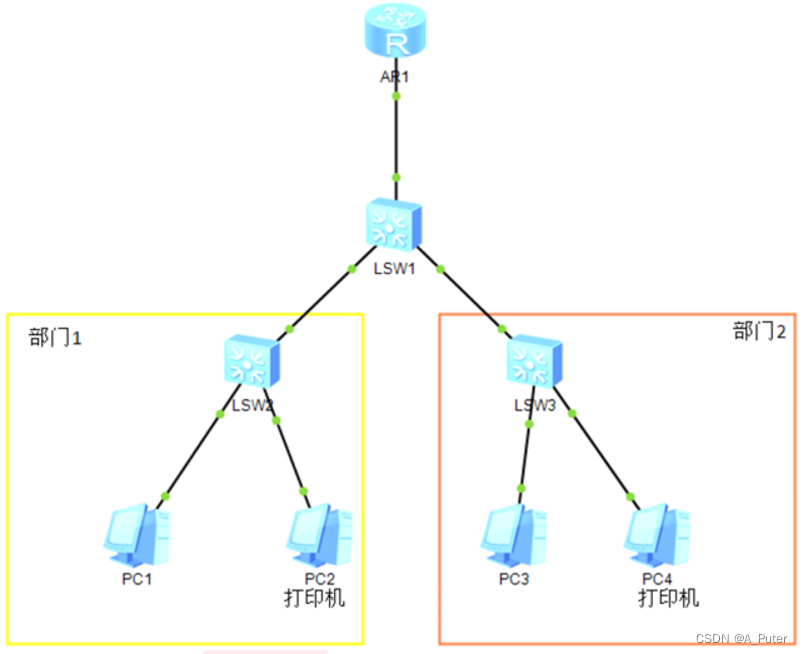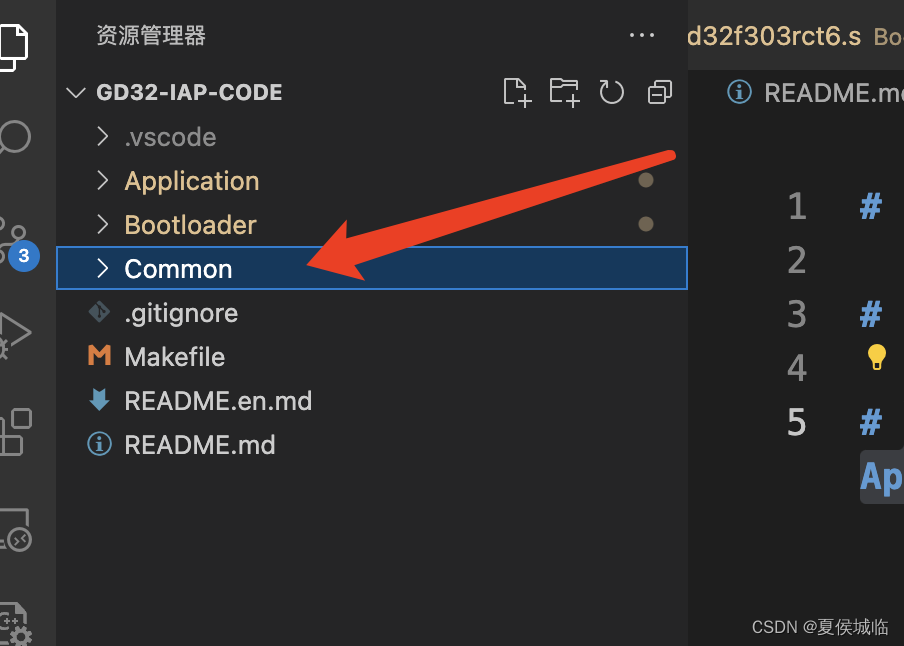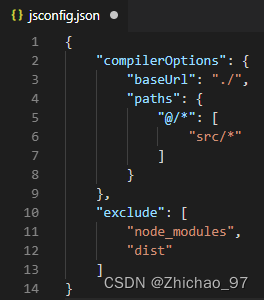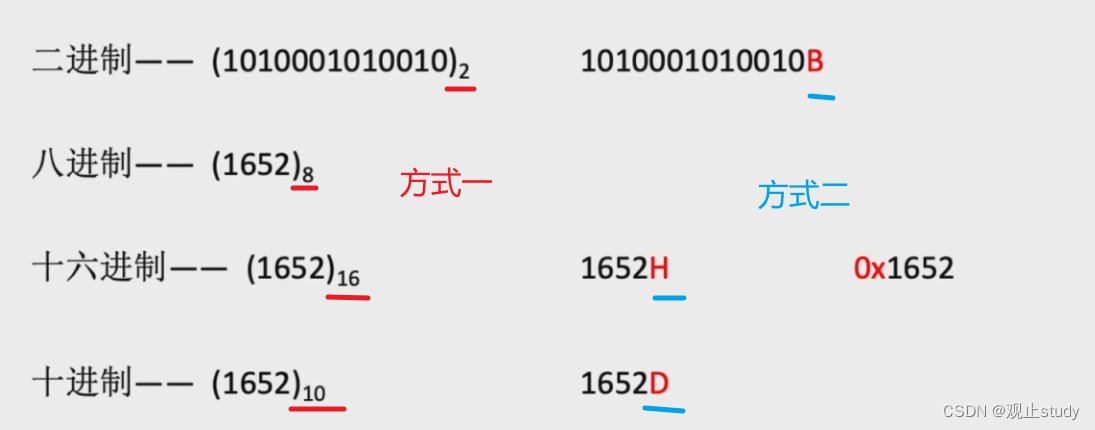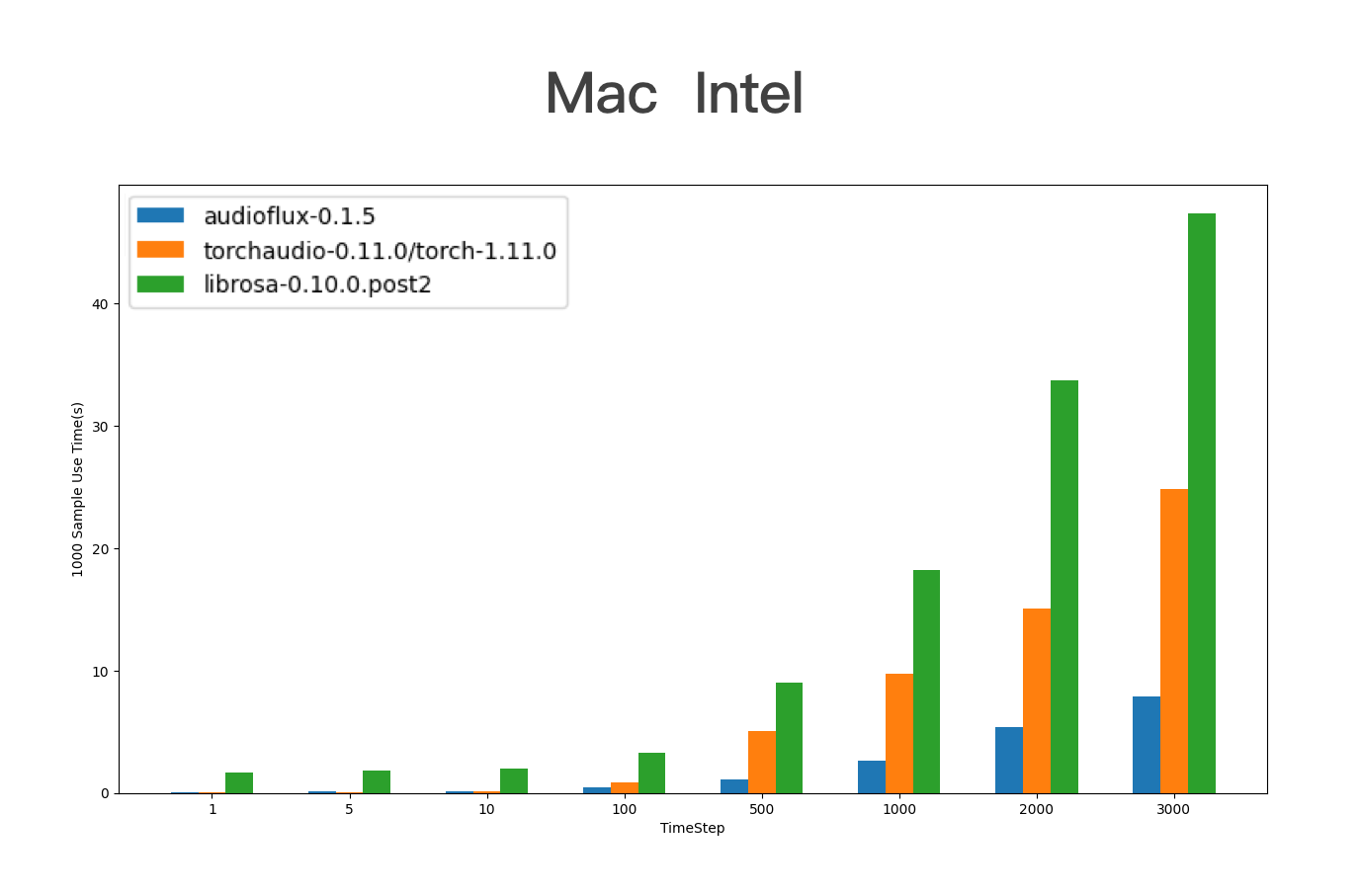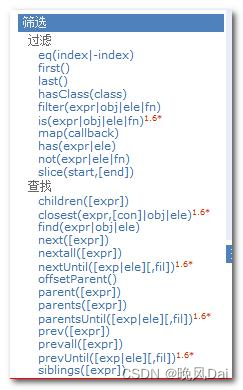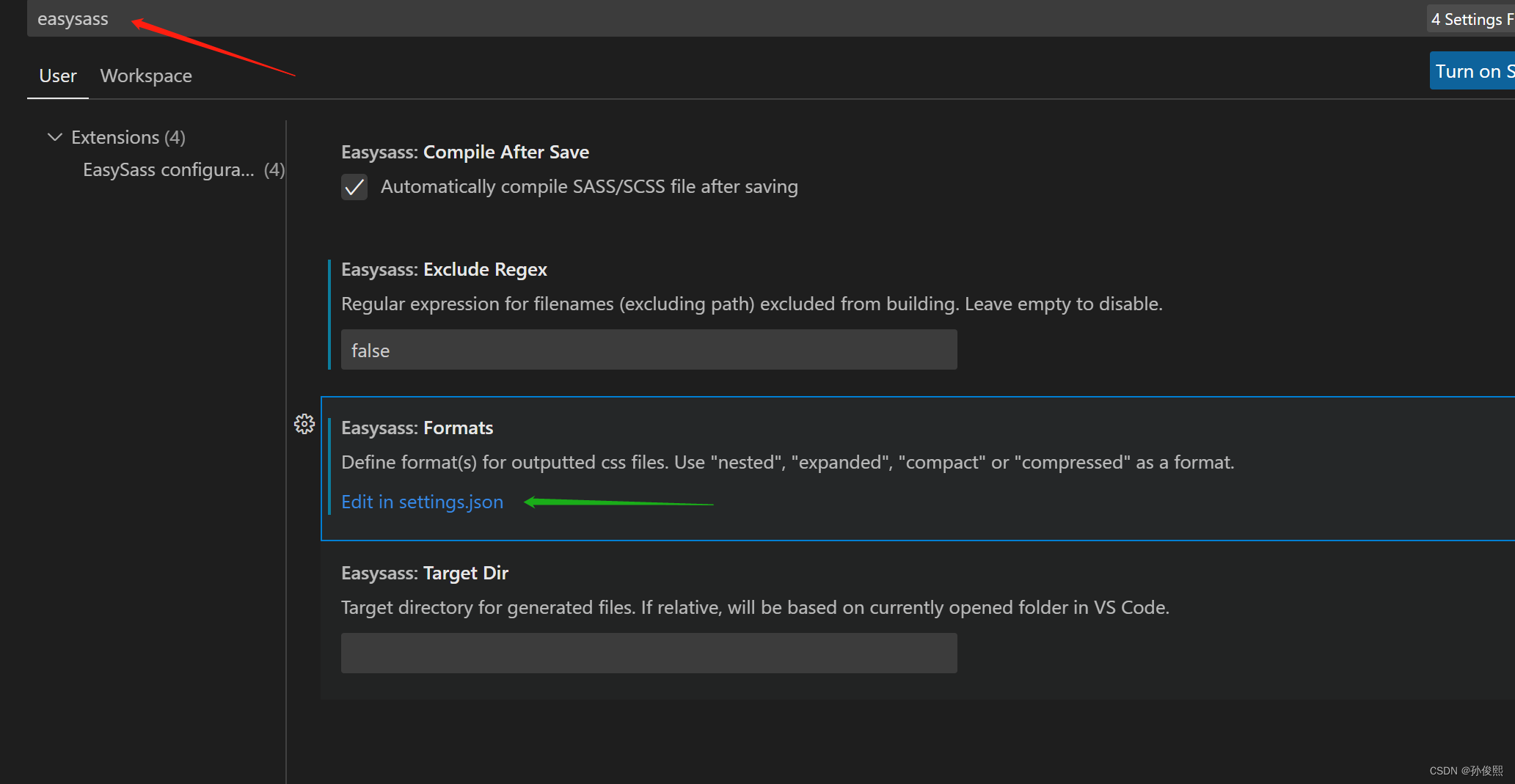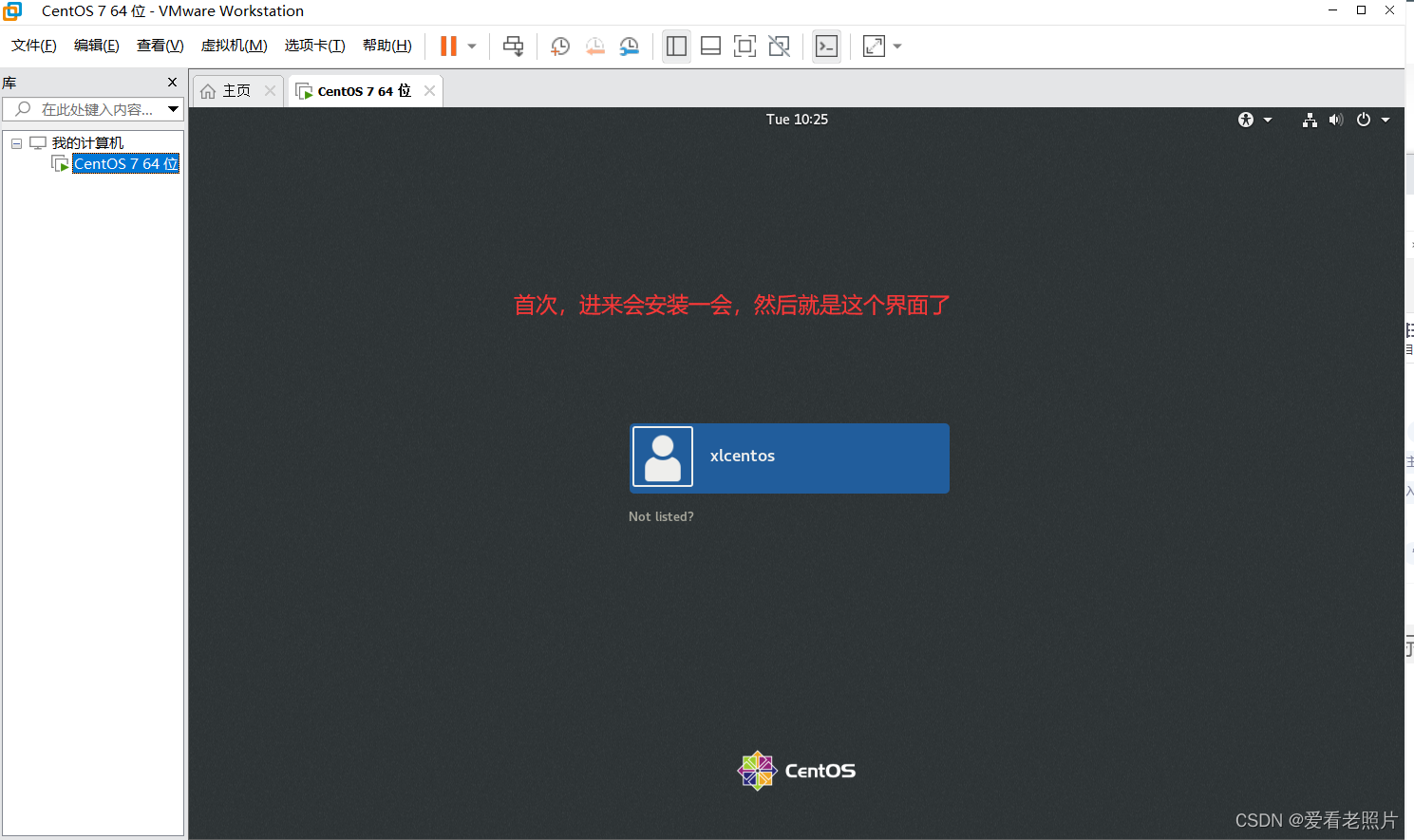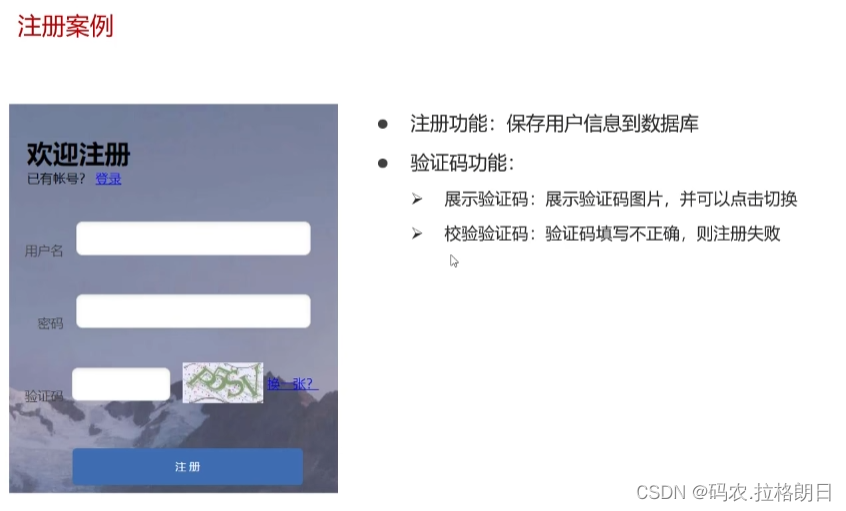
1. 注册功能改进
1.1 service
将之前的注册案例的代码进行优化,将获取
sqlsession工厂对象、获取sqlsession、获取mapper等操作从servlet中分离出来转变为三层架构的形式
在
service目录下创建UserService
public class UserService {
SqlSessionFactory sqlSessionFactory = SqlSessionFactoryUtils.getSqlSessionFactory();
/**
* 登录方法
* @param username
* @param password
* @return
*/
public User login(String username, String password){
//2. 获取SqlSession
SqlSession sqlSession = sqlSessionFactory.openSession();
//3. 获取UserMapper
UserMapper mapper = sqlSession.getMapper(UserMapper.class);
//4. 调用方法
User user = mapper.select(username, password);
//释放资源
sqlSession.close();
return user;
}
public boolean register(User user){
//2. 获取SqlSession
SqlSession sqlSession = sqlSessionFactory.openSession();
//3. 获取UserMapper
UserMapper mapper = sqlSession.getMapper(UserMapper.class);
//4. 判断用户名是否存在
if(mapper.selectByUsername(user.getUsername()) == null){
// 用户名不存在,注册
mapper.add(user);
sqlSession.commit();
sqlSession.close();
return true;
}else {
// 用户名存在
return false;
}
}
这里对4处的代码进行优化
//4. 判断用户名是否存在
User u = mapper.selectByUsername(user.getUsername());
if(u == null){
// 用户名不存在,注册
mapper.add(user);
sqlSession.commit();
}
sqlSession.close();
return u == null;
}
1.2 web层
从浏览器请求中获取数据(请求体中),将数据封装起来,并且调用方法判断是否需要添加用户
@WebServlet("/registerServlet")
public class RegisterServlet extends HttpServlet {
private UserService service = new UserService();
@Override
protected void doGet(HttpServletRequest request, HttpServletResponse response) throws ServletException, IOException {
//1. 接收用户数据
String username = request.getParameter("username");
String password = request.getParameter("password");
//转义操作
username = new String(username.getBytes(StandardCharsets.ISO_8859_1), StandardCharsets.UTF_8);
//封装用户对象
User user = new User();
user.setUsername(username);
user.setPassword(password);
//2. 调用方法
boolean flag = service.register(user);
//3. 判断成功与否
if(flag){
// 注册成功,跳转到login页面
request.setAttribute("register_msg", "注册成功,请登录");
request.getRequestDispatcher("/login.jsp").forward(request,response);
}else {
// 失败,要返回注册页面
request.setAttribute("register_msg", "注册失败,用户名已存在");
request.getRequestDispatcher("/register.jsp").forward(request,response);
}
}
@Override
protected void doPost(HttpServletRequest request, HttpServletResponse response) throws ServletException, IOException {
this.doGet(request, response);
}
}
2. 验证码
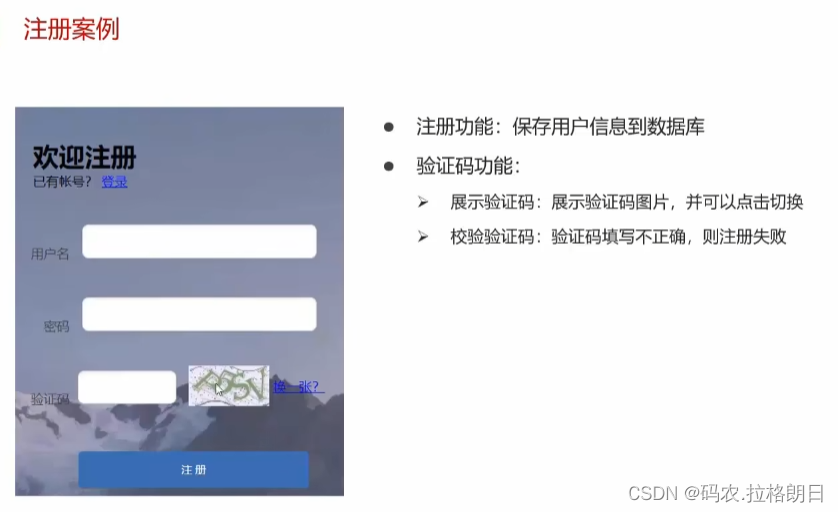
2.1 Java代码生成验证码图片
验证码工具类,输出随机验证码图片流,并返回验证码值,给出测试用例
package com.xj.util;
import javax.imageio.ImageIO;
import java.awt.*;
import java.awt.geom.AffineTransform;
import java.awt.image.BufferedImage;
import java.io.File;
import java.io.FileOutputStream;
import java.io.IOException;
import java.io.OutputStream;
import java.util.Arrays;
import java.util.Random;
/**
* 生成验证码工具类
*/
public class CheckCodeUtil {
public static final String VERIFY_CODES = "123456789ABCDEFGHIJKLMNOPQRSTUVWXYZ";
private static Random random = new Random();
// 测试用例
public static void main(String[] args) throws IOException {
OutputStream fos = new FileOutputStream("C:\\project_heima\\day10-JSP\\代码\\brand-demo1\\src\\main\\webapp\\imgs\\a.jpg");
String checkCode = CheckCodeUtil.outputVerifyImage(100, 50, fos, 4);
System.out.println(checkCode);
}
/**
* 输出随机验证码图片流,并返回验证码值(一般传入输出流,响应response页面端,Web项目用的较多)
*
* @param width 图片宽度
* @param height 图片高度
* @param os 输出流
* @param verifySize 数据长度
* @return 验证码数据
* @throws IOException
*/
public static String outputVerifyImage(int width, int height, OutputStream os, int verifySize) throws IOException {
String verifyCode = generateVerifyCode(verifySize);
outputImage(width, height, os, verifyCode);
return verifyCode;
}
/**
* 使用系统默认字符源生成验证码
*
* @param verifySize 验证码长度
* @return
*/
public static String generateVerifyCode(int verifySize) {
return generateVerifyCode(verifySize, VERIFY_CODES);
}
/**
* 使用指定源生成验证码
*
* @param verifySize 验证码长度
* @param sources 验证码字符源
* @return
*/
public static String generateVerifyCode(int verifySize, String sources) {
// 未设定展示源的字码,赋默认值大写字母+数字
if (sources == null || sources.length() == 0) {
sources = VERIFY_CODES;
}
int codesLen = sources.length();
Random rand = new Random(System.currentTimeMillis());
StringBuilder verifyCode = new StringBuilder(verifySize);
for (int i = 0; i < verifySize; i++) {
verifyCode.append(sources.charAt(rand.nextInt(codesLen - 1)));
}
return verifyCode.toString();
}
/**
* 生成随机验证码文件,并返回验证码值 (生成图片形式,用的较少)
*
* @param w
* @param h
* @param outputFile
* @param verifySize
* @return
* @throws IOException
*/
public static String outputVerifyImage(int w, int h, File outputFile, int verifySize) throws IOException {
String verifyCode = generateVerifyCode(verifySize);
outputImage(w, h, outputFile, verifyCode);
return verifyCode;
}
/**
* 生成指定验证码图像文件
*
* @param w
* @param h
* @param outputFile
* @param code
* @throws IOException
*/
public static void outputImage(int w, int h, File outputFile, String code) throws IOException {
if (outputFile == null) {
return;
}
File dir = outputFile.getParentFile();
//文件不存在
if (!dir.exists()) {
//创建
dir.mkdirs();
}
try {
outputFile.createNewFile();
FileOutputStream fos = new FileOutputStream(outputFile);
outputImage(w, h, fos, code);
fos.close();
} catch (IOException e) {
throw e;
}
}
/**
* 输出指定验证码图片流
*
* @param w
* @param h
* @param os
* @param code
* @throws IOException
*/
public static void outputImage(int w, int h, OutputStream os, String code) throws IOException {
int verifySize = code.length();
BufferedImage image = new BufferedImage(w, h, BufferedImage.TYPE_INT_RGB);
Random rand = new Random();
Graphics2D g2 = image.createGraphics();
g2.setRenderingHint(RenderingHints.KEY_ANTIALIASING, RenderingHints.VALUE_ANTIALIAS_ON);
// 创建颜色集合,使用java.awt包下的类
Color[] colors = new Color[5];
Color[] colorSpaces = new Color[]{Color.WHITE, Color.CYAN,
Color.GRAY, Color.LIGHT_GRAY, Color.MAGENTA, Color.ORANGE,
Color.PINK, Color.YELLOW};
float[] fractions = new float[colors.length];
for (int i = 0; i < colors.length; i++) {
colors[i] = colorSpaces[rand.nextInt(colorSpaces.length)];
fractions[i] = rand.nextFloat();
}
Arrays.sort(fractions);
// 设置边框色
g2.setColor(Color.GRAY);
g2.fillRect(0, 0, w, h);
Color c = getRandColor(200, 250);
// 设置背景色
g2.setColor(c);
g2.fillRect(0, 2, w, h - 4);
// 绘制干扰线
Random random = new Random();
// 设置线条的颜色
g2.setColor(getRandColor(160, 200));
for (int i = 0; i < 20; i++) {
int x = random.nextInt(w - 1);
int y = random.nextInt(h - 1);
int xl = random.nextInt(6) + 1;
int yl = random.nextInt(12) + 1;
g2.drawLine(x, y, x + xl + 40, y + yl + 20);
}
// 添加噪点
// 噪声率
float yawpRate = 0.05f;
int area = (int) (yawpRate * w * h);
for (int i = 0; i < area; i++) {
int x = random.nextInt(w);
int y = random.nextInt(h);
// 获取随机颜色
int rgb = getRandomIntColor();
image.setRGB(x, y, rgb);
}
// 添加图片扭曲
shear(g2, w, h, c);
g2.setColor(getRandColor(100, 160));
int fontSize = h - 4;
Font font = new Font("Algerian", Font.ITALIC, fontSize);
g2.setFont(font);
char[] chars = code.toCharArray();
for (int i = 0; i < verifySize; i++) {
AffineTransform affine = new AffineTransform();
affine.setToRotation(Math.PI / 4 * rand.nextDouble() * (rand.nextBoolean() ? 1 : -1), (w / verifySize) * i + fontSize / 2, h / 2);
g2.setTransform(affine);
g2.drawChars(chars, i, 1, ((w - 10) / verifySize) * i + 5, h / 2 + fontSize / 2 - 10);
}
g2.dispose();
ImageIO.write(image, "jpg", os);
}
/**
* 随机颜色
*
* @param fc
* @param bc
* @return
*/
private static Color getRandColor(int fc, int bc) {
if (fc > 255) {
fc = 255;
}
if (bc > 255) {
bc = 255;
}
int r = fc + random.nextInt(bc - fc);
int g = fc + random.nextInt(bc - fc);
int b = fc + random.nextInt(bc - fc);
return new Color(r, g, b);
}
private static int getRandomIntColor() {
int[] rgb = getRandomRgb();
int color = 0;
for (int c : rgb) {
color = color << 8;
color = color | c;
}
return color;
}
private static int[] getRandomRgb() {
int[] rgb = new int[3];
for (int i = 0; i < 3; i++) {
rgb[i] = random.nextInt(255);
}
return rgb;
}
private static void shear(Graphics g, int w1, int h1, Color color) {
shearX(g, w1, h1, color);
shearY(g, w1, h1, color);
}
private static void shearX(Graphics g, int w1, int h1, Color color) {
int period = random.nextInt(2);
boolean borderGap = true;
int frames = 1;
int phase = random.nextInt(2);
for (int i = 0; i < h1; i++) {
double d = (double) (period >> 1)
* Math.sin((double) i / (double) period
+ (6.2831853071795862D * (double) phase)
/ (double) frames);
g.copyArea(0, i, w1, 1, (int) d, 0);
if (borderGap) {
g.setColor(color);
g.drawLine((int) d, i, 0, i);
g.drawLine((int) d + w1, i, w1, i);
}
}
}
private static void shearY(Graphics g, int w1, int h1, Color color) {
int period = random.nextInt(40) + 10; // 50;
boolean borderGap = true;
int frames = 20;
int phase = 7;
for (int i = 0; i < w1; i++) {
double d = (double) (period >> 1)
* Math.sin((double) i / (double) period
+ (6.2831853071795862D * (double) phase)
/ (double) frames);
g.copyArea(i, 0, 1, h1, 0, (int) d);
if (borderGap) {
g.setColor(color);
g.drawLine(i, (int) d, i, 0);
g.drawLine(i, (int) d + h1, i, h1);
}
}
}
}
测试用例的结果


2.2 展示验证码

在注册表单当中添加验证码,获取的验证码图片属于动态获取,每一次访问都是不同的图片,所以创建
checkCodeServlet,每次访问由该servlet来返回新的图片
<tr>
<td>验证码</td>
<td class="inputs">
<input name="checkCode" type="text" id="checkCode">
<img id="checkCodeImg"src="/brand-demo1/checkCodeServlet">
<a href="#" id="changeImg">看不清?</a>
</td>
</tr>
创建
checkCodeServlet
@WebServlet("/checkCodeServlet")
public class CheckCodeServlet extends HttpServlet {
@Override
protected void doGet(HttpServletRequest request, HttpServletResponse response) throws ServletException, IOException {
ServletOutputStream os = response.getOutputStream();
String checkCode = CheckCodeUtil.outputVerifyImage(100, 50, os, 4);
}
@Override
protected void doPost(HttpServletRequest request, HttpServletResponse response) throws ServletException, IOException {
this.doGet(request, response);
}
}
另一个功能,看不清换一张,将验证码的表单修改
<tr>
<td>验证码</td>
<td class="inputs">
<input name="checkCode" type="text" id="checkCode">
<img id="checkCodeImg"src="/brand-demo1/checkCodeServlet">
<a href="#" id="changeImg">看不清?</a>
</td>
</tr>
并且添加相应事件
<script>
document.getElementById("changeImg").onclick = function (){
document.getElementById("checkCodeImg").src="/brand-demo1/checkCodeServlet";
}
</script>
这时会出现一个问题,换验证码图片只能响应一次之后就不会换图片了,这是因为被浏览器给缓存了,src路径被缓存了,就无法更换图片了,浏览器响应是尽量使用存在的缓存,所以需要改进。
解决办法:加时间戳
document.getElementById("checkCodeImg").src="/brand-demo1/checkCodeServlet?" + new Date().getMilliseconds();
最后一个功能,点击图片更换验证码
给img添加响应事件即可
document.getElementById("checkCodeImg").onclick = function (){
document.getElementById("checkCodeImg").src="/brand-demo1/checkCodeServlet?" + new Date().getMilliseconds();
}
2.3 验证码的校验

进行验证码的校验,必须将验证码存储在Session中,以便两个Servlet之间可以获取数据
先在CheckCodeServlet处存入Session
HttpSession session = request.getSession();
session.setAttribute("checkCodeGen", checkCode);
然后在RegisterServlet处读取Session
// 获取用户输入的验证码
String checkCode = request.getParameter("checkCode");
// 程序生产的验证码,从Session中获取
HttpSession session = request.getSession();
String checkCodeGen = (String) session.getAttribute("checkCodeGen");
// 比对
if(!checkCodeGen.equalsIgnoreCase(checkCode)){
request.setAttribute("register_msg","验证码错误");
request.getRequestDispatcher("/register.jsp").forward(request,response);
// 不允许注册
return;
}
验证码一般是忽略大小写比对的,所以用
equalsIgnoreCase()
